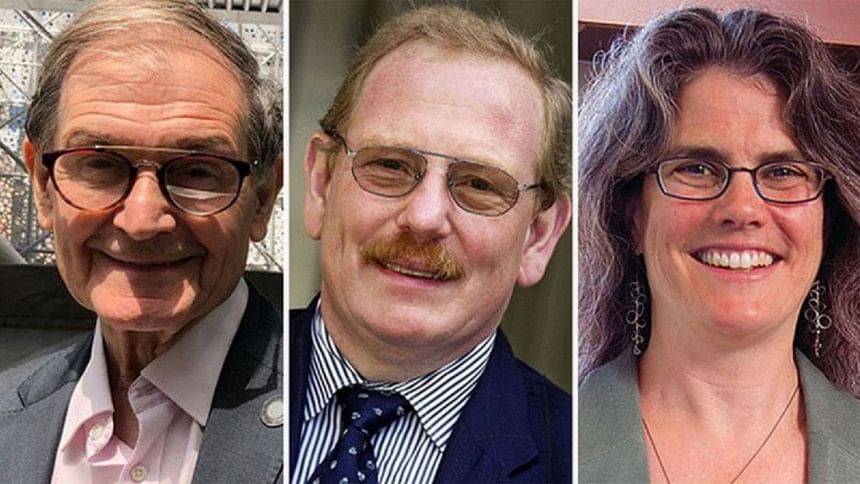Roger Penrose, Black Holes and the 2020 Nobel Prize in Physics

Three scientists have been awarded the 2020 Nobel Prize in Physics. They are the British mathematical physicist Roger Penrose, German astrophysicist Reinhard Genzel, and American astronomer Andrea Ghez.
Penrose, a professor at Oxford University, is recognised for his research on black holes carried out in the 1960s. According to the Royal Swedish Academy of Sciences, Penrose has been honoured "for the discovery that black hole formation is a robust prediction of [Albert Einstein's] general theory of relativity." Professors Genzel of Max Planck Institute and Ghez of the University of California in Los Angeles were awarded the prize "for the discovery of a supermassive compact object" in a region called Sagittarius A*, located at the centre of our galaxy, The Milky Way.
The criteria for awarding Nobel Prize in Physics are defined in specific terms. Alfred Nobel's will stipulates that the prize should be awarded "to the person who made the most important discovery or invention in the field of physics." The crucial words in the will are "discovery" and "invention." It is arguable whether developing a theory can be considered a discovery per se, but it is certainly not an invention in the sense that we normally associate an invention with. That is why the prize is seldom given to theoretical physicists, unless their theory is testable or verifiable.
When theorists won the prize by themselves, for example John Bardeen, Leon Cooper and Robert Schrieffer for their theory of superconductivity, it was for a major theoretical formulation of an existing phenomenon, and thus can be considered as part of the "discovery" of that phenomenon. And theoretical physicists Peter Higgs and François Englert were awarded the Nobel Prize after the particle—Higgs Boson—predicted by their theory to complement the Standard Model of the Universe was experimentally detected.
While the awards to Genzel and Ghez are incontrovertible because they fit Nobel's criteria quite nicely, Penrose is a rather unusual choice in that his award is not for a discovery. It is for using ingenious mathematical methods to reveal the implications of Einstein's tour de force—the intimidatingly difficult-to-comprehend Theory of General Relativity.
However, long before Penrose's prize-winning work on black holes, German physicist Karl Schwarzschild provided the proof of their existence just less than two months after Einstein published the general relativity equations in 1915. By solving the equations exactly, he identified a radius, known as the Schwarzschild radius that defines the horizon or boundary of a voracious gravitational sinkhole—a single point of zero volume and infinite density.
If a massive object could be compressed to fit within the Schwarzschild radius, which is three kilometres per solar mass, no known force could stop it from collapsing into the sinkhole. Today, we call this sinkhole a black hole. His work formed the basis for later studies of black holes, showing that the concentration of matter in a black hole is so great that no light could escape its staggering gravitational pulls, but rather follow a trajectory curving back towards the black hole, thereby making it unobservable.
Lest we forget, Einstein did not win the Nobel Prize for his revolutionary work on general relativity or special relativity. The Nobel Committee decided against them on grounds that the relativity theories were abstract and unproven, although observational proof of general relativity was provided in 1919 by the Cambridge astrophysicist Arthur Eddington. He famously measured the deflection of starlight passing near the Sun during a total solar eclipse. The deflection, known as gravitational lensing, resulted from warping of space, as predicted by general relativity. Instead, Einstein received the deferred 1921 prize in 1922 for his 1905 quantum interpretation of the photoelectric effect because it can be attributed to the discovery of the effect—emission of electrons from metal surfaces under certain illuminations—by the German physicist Heinrich Rudolph Hertz in 1887.
Despite his fame and impact on theoretical physics, Nobel Prize eluded the brilliant physicist, mathematician and cosmologist Stephen Hawking, even though there is a general consensus that he has done more than anyone else since Einstein to deepen our knowledge about the cosmos. As noted by Penrose, a Nobel Prize for Hawking would have been "well-deserved" yet was possibly held back by the committee's desire to honour observable, rather than theoretical scientific studies that are difficult, or almost impossible, to verify experimentally. Penrose's work, albeit monumental and worthy of the Nobel Prize, cannot also be experimentally verified because of the very nature of the topics. So why relax requirements for work which are mostly theorems, some hypothesised in collaboration with Hawking?
Penrose is not the first scientist to predict the existence of black holes. The idea of black holes dates back even before Schwarzschild, to 1783, when an English cleric and amateur scientist named John Michell and more than a decade later French mathematician Pierre-Simon Laplace used a thought experiment to explain that light would not leave the surface of a very massive star if the gravitation was sufficiently large. Michell called them "dark stars."
In 1930, during a long voyage to London, 19-year-old Indian astrophysicist Subrahmanyan Chandrasekhar showed via calculations that when a massive star runs out of fuel, it would blow itself apart in a spectacularly violent explosion into a black hole. He received the Nobel Prize in 1983, not for his work on black holes, but for "studies of the physical processes of importance to the structure and evolution of the stars."
For decades, the concept of black holes was no more than a mathematical aberration. They are well-nigh impossible to detect because light, one of our cosmic messengers, cannot escape from black holes. Hence, there is a total information blackout. How do we then infer about their existence? As the physics of black holes developed through the years, physicists realised that indirect routes were available. Consequently, our current understanding of black holes is built on inference drawn from data collected by X-ray, optical and radio telescopes.
Indeed, their existence was eventually confirmed in 1971 when astronomers detected a hint of radio wave emissions coming from an object in the constellation Cygnus. The emissions were later interpreted as the fingerprint of the black hole Cygnus X-1. Since then, numerous black holes, including supermassive ones, have been detected in our galaxy and elsewhere in the Universe.
Quamrul Haider is a Professor of Physics at Fordham University, New York.

 For all latest news, follow The Daily Star's Google News channel.
For all latest news, follow The Daily Star's Google News channel. 



Comments